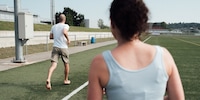
Background information
Running coaching: fighting your habits
by Michael Restin

I want to learn more about the human walk. To do so, I need to go right into detail. Experts in motion analysis at Balgrist University Hospital in Zurich are helping me on my voyage of discovery. This is the story of a first step and its consequences.
Mark Huybrechts places marker after marker. The physiotherapist palpates my limbs and joints, shaves the last of the hair from my shins, and uses me as a canvas for his green felt-tip pen. Then, working his way from my feet, right up to my shoulders, he sticks me with 53 small, reflective balls. I’m measured, weighed, moved, photographed and questioned. Sixteen electrodes register my every muscle twitch.
Force plates hidden in the floor lie in wait for my footsteps, while infrared and video cameras record every movement. In front of me, I have just ten metres of mouse-grey floor, a white line and brightly coloured markings. I couldn’t say where any of this is leading. Other than to new discoveries, of course. And to irritating adjectives at the debriefing the following week.
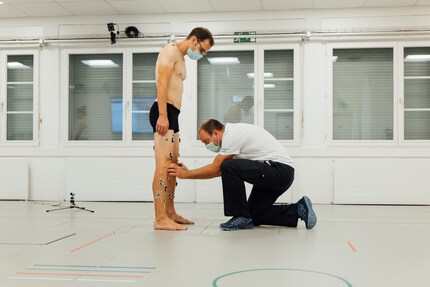
I'm in the motion analysis lab at Balgrist University Hospital, where physiotherapist Mark Huybrechts, sports scientist Dr. Gerda Strutzenberger and head physician Prof. Johannes Scherr are examining something as individual as our fingerprint: gait analysis. Every movement pattern is unique, and with every step we take, so much happens in the body that the whole endeavour resembles a small miracle. Unbelievably, we take it all for granted. We often hear the question «how’s it going?» but rarely «how’re YOU going?» The former is a typical small talk starter, which we usually respond to with «fine» – even when it’s not true.
Just as we fight to maintain a facade, our bodies mask emerging problems too. They strive for balance, redistribute burdens, fight to keep the system running – until they no longer can. The painful truth is that even for amateur runners, overstrain and injuries are more the rule than the exception, leading many to give up the sport entirely. I’m not there yet, but I know that not everything’s exactly tickety-boo with me either. Nevertheless, when Huybrechts and Strutzenberger greet me with the question, «How are you, Michael?» I answer, «Fine.» We’ll see about that.
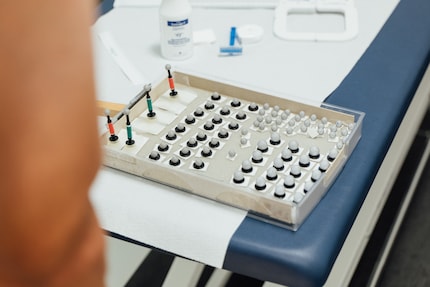
Over the coming months, I want to take you along on this personal quest of mine. We’ll be learning about how things are connected. Regardless of whether you’re sporty or not, most of us at least walk. So, it’s good to know where problems surface and what impact they can have. Which is why I’ve taken on the role of lab rat, poised at the starting line. The data will be a starting point for exploring issues related to running in greater depth. There are plenty of questions: what happens in the feet, the knees, the hips? What’s normal – and what isn’t? What can be trained? Is there such a thing as the perfect walk? And if so, what does it look like?
Professor Scherr, Head of the University Centre for Prevention and Sports Medicine at Balgrist University Hospital, sighs contemplatively at this idea. «Someone with the perfect gait doesn’t necessarily walk or run perfectly,» he says. It always depends on the test group and their individual challenges. He continues, «Usain Bolt is a perfect sprinter from a biomechanical point of view.» A hurdler, on the other hand, would be judged on a different set of criteria.
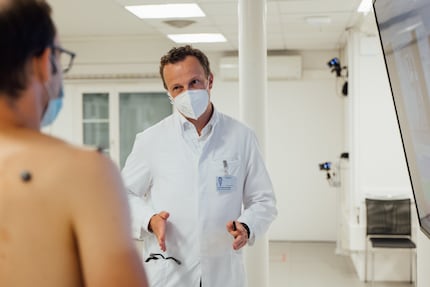
The answers won’t be simple – the context behind them is too complex. My first task, however, is plain and simple. «Please start walking now,» a monotone computer voice demands.
I only need to walk ten or eleven steps before I’m transformed into a catwalk model. Back and forth, and back and forth again through the sterile room full of cameras. They’re gathering data, piling it up with every movement. My reference point is more the general population than Usain Bolt: a healthy average that’ll give me an idea of where I stand. Or rather, HOW I stand. And walk.
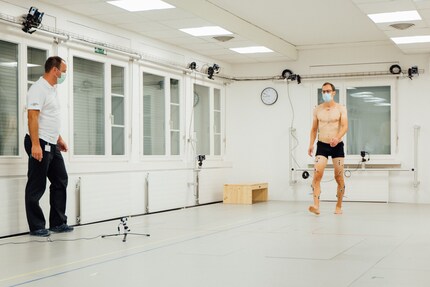
The fact that my anatomy takes an idiosyncratic turn below the knees is so evident that I'm not surprised by Gerda Strutzenberger's blunt assessment of my avatar on the screens: «Evidently you have bow legs.»
It’s an insight that requires neither markers nor sensors, nor 3D models of my body axes. These tools are needed in order to understand the whole picture, and to gauge what that means for the gait. «What’s extraordinary about this is that I can look at the whole picture and incorporate the entire chain of movement into it,» says Strutzenberger. A video alone couldn’t show the internal strain.»
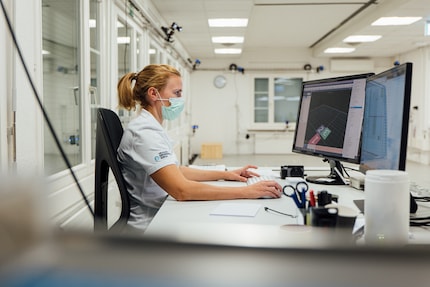
Motion analysis is one piece of the diagnostic puzzle. It’s how different forces and their impact, normally invisible to the naked eye, are revealed. «The big advantage comes to the fore when it’s combined with other methods,» Huybrechts adds. An MRI or X-ray image reveals structural problems, while motion analysis shows what they mean for the system as a whole. People with malpositions or injuries benefit just as much from it as athletes looking to enhance their performance.
On the monitors, my body is covered in green, red, blue, and yellow lines dictated by the position of the markers. From another perspective, I’m a colourful mass of dots dancing through the spaces of a black grid. Muscle activity data flickers across Strutzenberger’s screens in addition to that.
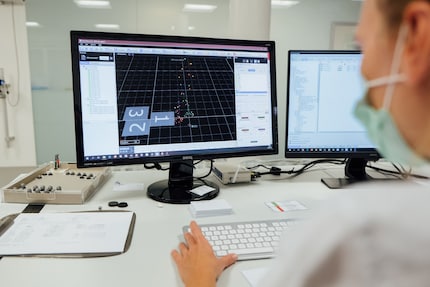
Mark Huybrechts makes sure that everything on the outside of my body is in order. He adjusts the reflectors, tweaks the position of the sensors and practices walking with me. «We’re now looking for the best starting position,» says the physiotherapist and specialist in neuro-orthopaedics, giving me instructions in a calm and friendly manner. «Go to the blue line and plant your feet on either side of the white line. Then just start walking at a normal pace.»
Normal. What even is normal? The atmosphere may be relaxed, but I’m also standing in my underpants in front of a load of cameras, covered in sensors, all the while trying to follow a line on the ground under the watchful eye of the researchers. Like a scared lab rat, I start doing mental gymnastics over every step. «The patients are usually a little hesitant at first,» says Strutzenberger, «but we want to map the normal gait pattern, which takes some time to get to.» Only then is the data meaningful.
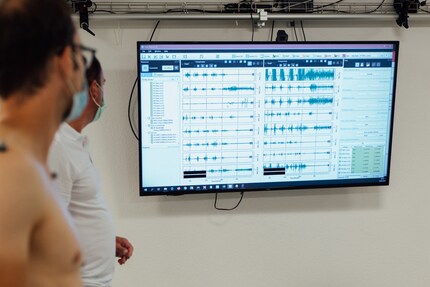
It’s not until after the process that I understand everything the researchers were doing to me. The system isn’t the only thing to be calibrated at the beginning – turns out I am, too. As I’m getting used to walking in the suit of sensors, they direct me in a way that makes me unknowingly step on the force plates in the floor. Doing this will demonstrate how my feet bear my weight. The more frequently I step on them, the better the data.
«We try to get between five and eight footprints per leg so we can then calculate an average value for each side,» Gerda Strutzenberger tells me later. Every bit of me, from the soles of my feet to my torso, gets recorded, allowing for a look at my walk in its entirety. At some point, routine sets in. I walk evenly, and I stop accidentally knocking the antenna-like markers off my legs with the nearest chair leg. Both the markers and my footsteps have found their rightful places: the real measurement can begin. A large part of the work lies in meticulous preparation.
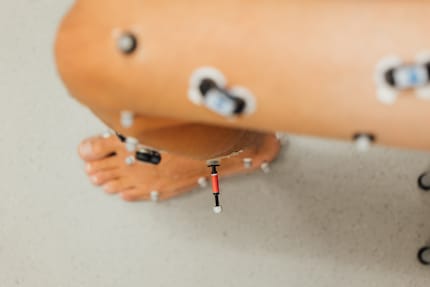
From an outside perspective, the back and forth is nothing spectacular – the data obtained is. «In the past, it would have taken a week to capture all of this,» Strutzenberger explains. We're preoccupied with this for about an hour and a half until she says, «Now, over three seconds, we'll measure what your muscle signals are like at rest.» Three seconds later, laughing, she says, «That's the relaxation bit over, thanks! We don’t have much time for that here!» There’s still a fair bit to do – data takes work, after all. I’ll find out in a week’s time how it’ll be judged. With a fluttering heart instead of electrodes on my body.
«From the visual side of things, it's exciting,» says Chief Medical Officer Scherr. With a slight smile, he says, «Or interesting.» Dramatic pause. «That's usually what you say in a restaurant when you’re served a slightly dodgy meal, then asked how it tasted.»
What’s actually served up to me is a number of discoveries, none of which surprise me: «What we see in your legs is known as Genua Vara.» Yep, I know. The term has nothing to do with the Italian port city, and everything to do with my bow legs, which are throwing all the statistics into disarray.
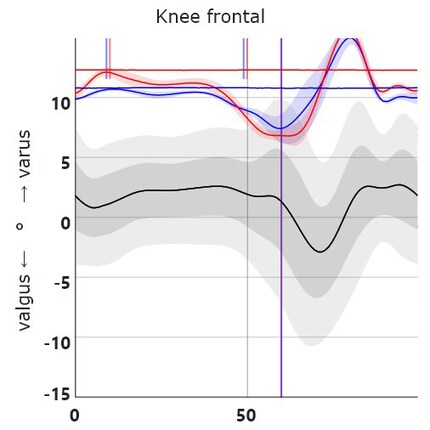
What’s more surprising is the expert view of my anatomy; with images and data bringing the less obvious to light. «This is your gait cycle, which we break down and compare to the norm,» says Gerda Strutzenberger, pointing to her screen. «Here, you're standing with your foot on the ground – which is the stance phase. There’s your leg in the air – which is the swing phase,» she explains, tracing the red and blue lines that represent my left and right leg. In some areas, they follow the norm; in others, they veer wildly away from it. Even in body parts that I hadn’t really taken a look at before.
Strutzenberger launches into an academic lecture: «Your ankle is a little more dorsally extended because you have this flexion in your knee.» Scherr translates, «because you have a bend in your knee, your lower leg is tilted more to the front.» I find out that I can't even fully extend my leg. I also learn the consequences of that, as well as everything else that’s wrong: from my misaligned pelvis down to my feet, which have quite the arch. The fact that my foot rolls along the outer edge when walking is only logical due to the curvature of my shins. After all, «the movement chain is all connected». Muscles, bones, nerves, tendons and joints share a common destiny.
Given that the pressure on my knees is practically off the scale, it’s astounding that my legs are still attached. «Straight into the first half of the standing phase, you have considerably higher pressure,» says Strutzenberger, just managing to indicate the blue and red lines way outside of the normal spectrum. When my foot hits the floor, a very high level of torque kicks in in my knees. This has consequences: «The middle of your thigh muscle becomes extremely pronounced, because the body tries to offset the pressure,» says Scherr. Basically, it's as if someone built a model that can’t actually hold together, and then patched it up with Duct Tape. Sub-optimal. At least the body is smart enough to build muscle in the critical areas.
Just as I'm mentally regressing from modern man to Neanderthal man on the famous chart on the theory of evolution, I have to cope with another blow. «On average, a hip joint can rotate about 90 degrees outwards and inwards combined,» explains Mark Huybrechts. You have a range of 20 to 15 on the left side, which is...different.»
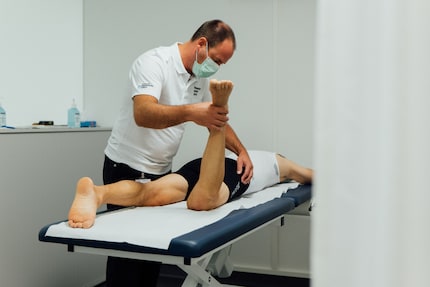
Yet another polite adjective. «There are probably structural reasons for it,» Scherr says. «That's why I find it remarkable that walking has been reasonably pain-free for you so far.» We continue in this style from hips to soles for a while. I get the feeling that this is the first time in 40 years I’ve really got to know my legs.
Interesting, different, remarkable – at this moment I’d prefer to change careers from lab rat to magician’s rabbit; hop into a top hat and be transformed. Scherr, however, is more inclined towards the trick with the saw. Whichever way my hips are swinging – or not – the main problem is the pressure on my knees. He records what happens during a realignment osteotomy:«You cut a wedge out of the tibia to correct the misalignment.» This is either done at a young age, or when chronic pain sets in during adulthood. For me, this hasn’t yet been the case.
«At this point in time, you have a reasonably stable system,» the chief physician reassures me. «And as the saying goes, 'never change a running system'.» I’m a walking Windows XP, reasonably stable, waiting for the system to crash. I’m still going. With stiff hips and bow legs. But it’s alright. I always say the human walk borders on the miraculous. Not just mine, but in general. It’s worth going into detail, getting familiar with the structures involved, training, tweaking and brushing up on common ailments. I want to do it together with the experts at the Centre for Prevention and Sports Medicine, step by step, starting off with the feet – an often neglected part of the body that plays an important supporting role.
Simple writer and dad of two who likes to be on the move, wading through everyday family life. Juggling several balls, I'll occasionally drop one. It could be a ball, or a remark. Or both.
Interesting facts about products, behind-the-scenes looks at manufacturers and deep-dives on interesting people.
Show all
Background information
by Michael Restin

Background information
by Michael Restin

Background information
by Michael Restin